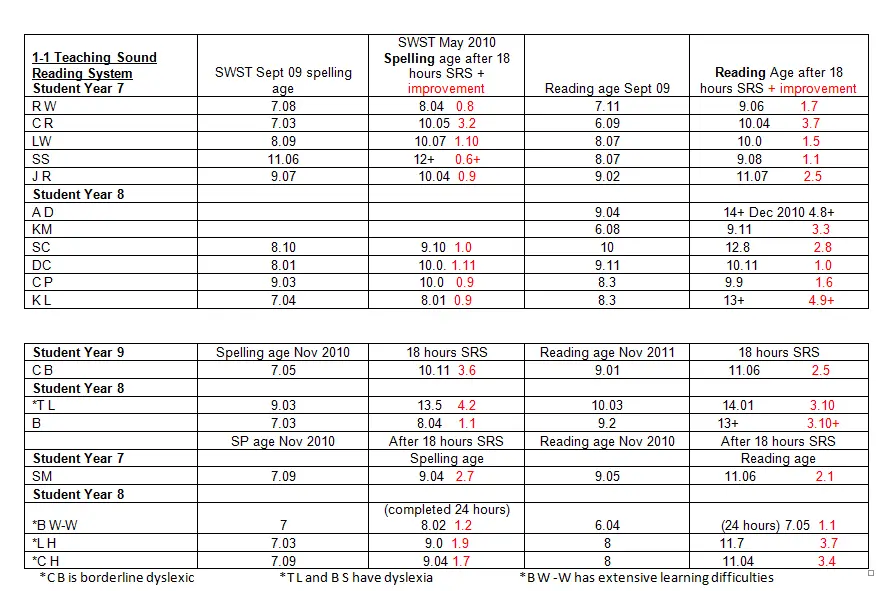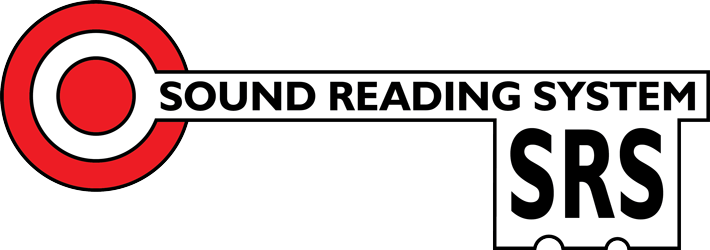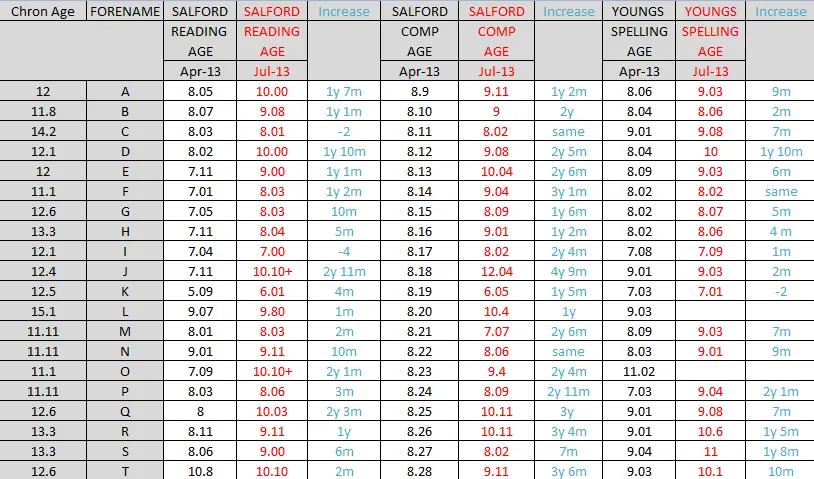Teaching in Simple Logical Steps
Developed for teachers and parents to enable beginners and struggling readers to unlock the English spelling code, in simple logical steps that promote understanding.
Year 7 and 8 Pupils
The results of 20 Year 7 and 8 pupils after 10 SRS lessons – 1 hour + 3 x 20 minutes sessions a week. The results shown here are the results of one SENCo working 1-1 with year 7 pupils and a few Year 8 pupils in a Secondary School in Liverpool.
This teacher was trained in February 2013 and began teaching her pupils in April 13, retesting them in early July 13. She said that the pupils had approximately 10 lessons (10 x 1 hour lessons, one a week) plus 3 x 20 minutes support work per week, amounting to 2 hours teaching per week. She also stated that these pupils did not always have the full 2 hours due to absence and late arrival at the lessons.
The pupils’ Chronological Age is shown in the far left hand corner and their name simply as an alphabet letter. Their pre -teaching Reading Age is recorded next, followed by their post- teaching Reading Age (red) and the increase shown years and or months in blue. This pattern is continued through the charts, showing the pupils’ comprehension and spelling age pre- and post- teaching.
Notice that Pupil ‘C’ RA and CA appear to have remained the same but their SP has increased by 7months. The teacher has continued teaching this very dyslexic pupil who has quite severe short term memory difficulties and says the improvement will show in January 2014 when she plans to re test. Pupil ‘I’ is also a young learner with the dyslexic label but their CA has greatly increased.
Many of the pupils have made significant gains in both RA and CA –see pupils A, D, J, O, Q for example, with Comprehension scores far exceeding Reading scores for the most part. This is probably due to the code having started to become embedded and therefore meaning comes more easily off the page as the learner reads, even though they may well be still self –correcting as they read. This is a common phenomenon when using the SRS programme. SRS suggests a minimum of 18 lessons so that the code has more chance of being consolidated.
The older the pupil, the more difficult it is to raise Spelling ages quickly, as the longer the learner has exercised inaccurate spelling, the more embedded these spellings have become. These learners are in years 7 and 8 and have therefore had 7 or 8 years of poor spelling behind them.
Academy Pupils (Years 7, 8 and 9)
A Northamptonshire Academy results after using SRS for Reading and Spelling.

Secondary School Pupils (Years 4–8)
Notes from an SRS Teacher in a Secondary School.
Martyn – Year 7
Martyn’s grades however do still suffer because of his dyslexia and I find it difficult to read a lot of his work unless he is translates for me; reading level 2a. Autumn term, after 6 weeks SRS – reading level 4a. Martyn has made fantastic progress this year since he has been attending the Sound Reading classes. His confidence has grown immeasurably when writing and instead of bunching letters together because he is not sure of the spelling, his writing is clear and readable.
Stephan – Year 7
Beginning of Year 7 Stephan could only write a short paragraph in 45 minutes; reading level 2a. After 6 weeks of SRS he was writing 3x as much in only 30 minutes and his spelling had greatly improved. His confidence had grown and he would write on the whiteboard in front of the class which he would never have done before. After 18 hours SRS, reading level 3a.
Other students
Year 7 student Mara Level 2a. After 18 hours SRS level 5c
Year 8 student Zubair level 2b. After 18 hours SRS level 3a
Year 7 student unable to read. After 18 hours SRS level 3a
Year 8 student level 2c. After 18 hours SRS level 4c
Year 4 student Oliver who could not read. After 18 hours SRS his reading went up 5 levels.
Year 5 student Daniel, severely dyslexic and unable to read. After 18 hours SRS level 3c.

